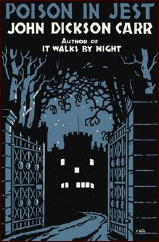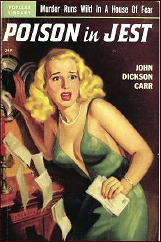Wed 1 Jan 2014
JOHN DICKSON CARR – Poison in Jest. Harper, US, hardcover, 1932. H. Hamilton, UK, hardcover, 1932. Reprinted many times in both hardcover and soft.

The magic word in describing the prose of John Dickson Carr is “atmosphere.” His stories always seem to be taking place in dark and dreary locales even when the sun is shining brightly. Let me quote from pages 28-29 of the British Penguin paperback I’ve just read:
According to Hubin, this early novel is a non-series one, but the narrator is the same Jeff Marle who assisted Henri Bencolin, the head of the Paris police, in several earlier cases. (This one takes place somewhere in Pennsylvania, and Bencolin does not appear.)

Even though Marle does his investigative best on the cae of domestic poisonings, he does not have the makings of a true Carr detective Neither does the county detective, Joe Sargent, who is called in. They see things too straight-forwardly, and the fail to see what things really mean.
It falls upon a friend of the family’s youngest daughter Virginia, an eccentric chap named Rossiter, to come upon the scene and ferret out the truth. In the grand tradition of Gideon Fell and Sir Henry Merrivale, Rossiter’s appearance makes him seem nearly potty in his behavior — but as is finally revealed, there is method in his madness. (As the saying goes.)
I don’t believe that this is one of Carr’s finer attempts at massive misdirection, as he is so prone to do, and the pace is rather stodgy and slow. I realized who had done it on page 154 of the Penguin edition (so that this won’t help you any), and there were still over 60 pages to go. (Which rather proves both points, doesn’t it?)
On the other hand, second-rate John Dickson Carr (which I”m really implying) is still more interesting to read than 90% of the work produced by anyone else who attempts the rigorous challenge of the old-fashioned fair-play detective mystery.
Note: In the most recent edition of Crime Fiction IV, Al Hubin now lists Jeff Marle as a series character. In the other five cases in which he takes part, it was always in tandem with Henri Bencolin.
January 1st, 2014 at 4:25 pm
Steve, There’s a typo in the fifth paragraph — “Sir Henry Merrivale” NOT “Sire Henry …”
January 1st, 2014 at 6:14 pm
Have to agree this isn’t prime Carr considering the period, but even second rate Carr is better than most, and I might have liked to see more of Rossiter in a better book. Marle is an attractive enough narrator, especially in the Bencolin books, but not enough to be the main sleuth.
Certainly atmosphere is a word you can’t avoid when writing about Carr, though in general the other word (aside from misdirection and miracle) is humor. Carr is one of the few writers in the specialized genre of the classic detective story who actually is humorous when he intends to be (while I love Iles, I always found Berkeley as Berkeley more annoying than humorous). I know that offends some readers and critics, but it brings a balance to what would otherwise be a pretty grim investigation in many of Carr’s books.
And I’ll give Carr this, his sleuths are the most high handed in the genre since Sherlock Holmes.
January 1st, 2014 at 6:27 pm
Randy
Fixed! And thanks!!
July 27th, 2020 at 6:28 pm
[…] their target, but one of them does, and more violence happens in its wake. Moment by moment, the novel comes to resemble the house: It’s a closed, tension-wrought space in which an aura of dread […]